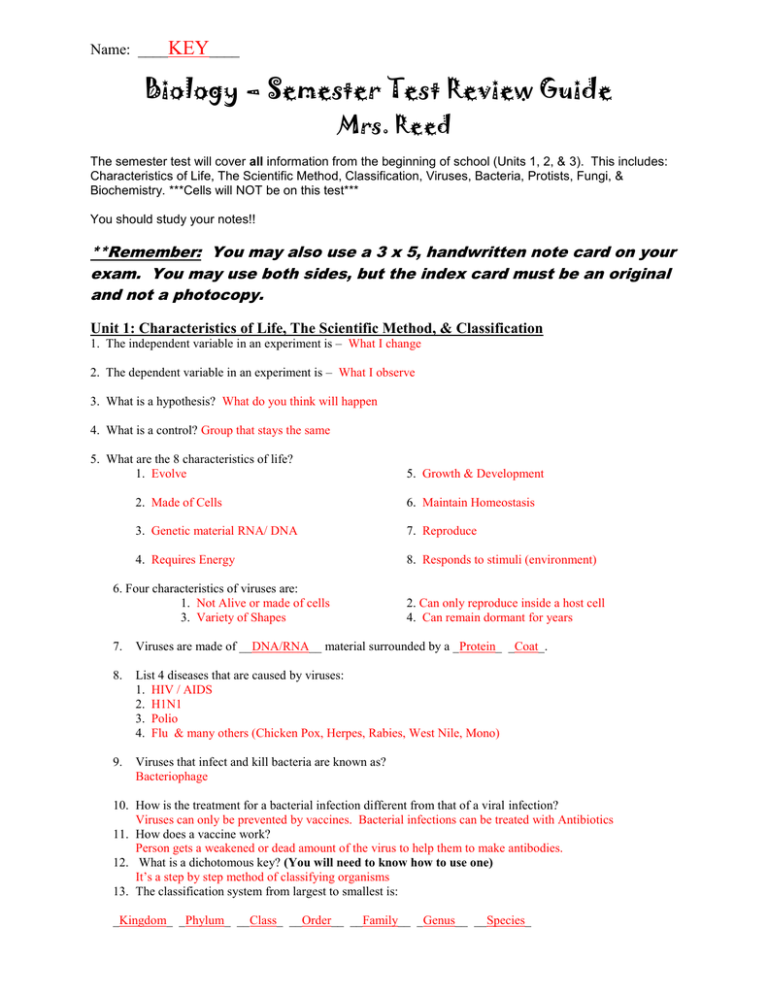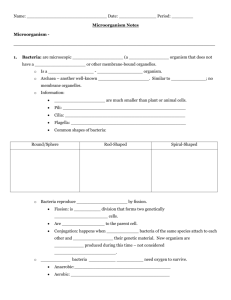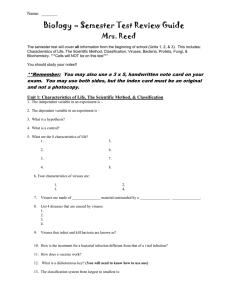Biology – Semester Test Review Guide Mrs. Reed KEY Name: ____
advertisement

Name: ____KEY____ Biology – Semester Test Review Guide Mrs. Reed The semester test will cover all information from the beginning of school (Units 1, 2, & 3). This includes: Characteristics of Life, The Scientific Method, Classification, Viruses, Bacteria, Protists, Fungi, & Biochemistry. ***Cells will NOT be on this test*** You should study your notes!! **Remember: You may also use a 3 x 5, handwritten note card on your exam. You may use both sides, but the index card must be an original and not a photocopy. Unit 1: Characteristics of Life, The Scientific Method, & Classification 1. The independent variable in an experiment is – What I change 2. The dependent variable in an experiment is – What I observe 3. What is a hypothesis? What do you think will happen 4. What is a control? Group that stays the same 5. What are the 8 characteristics of life? 1. Evolve 5. Growth & Development 2. Made of Cells 6. Maintain Homeostasis 3. Genetic material RNA/ DNA 7. Reproduce 4. Requires Energy 8. Responds to stimuli (environment) 6. Four characteristics of viruses are: 1. Not Alive or made of cells 3. Variety of Shapes 2. Can only reproduce inside a host cell 4. Can remain dormant for years 7. Viruses are made of __DNA/RNA__ material surrounded by a _Protein_ _Coat_. 8. List 4 diseases that are caused by viruses: 1. HIV / AIDS 2. H1N1 3. Polio 4. Flu & many others (Chicken Pox, Herpes, Rabies, West Nile, Mono) 9. Viruses that infect and kill bacteria are known as? Bacteriophage 10. How is the treatment for a bacterial infection different from that of a viral infection? Viruses can only be prevented by vaccines. Bacterial infections can be treated with Antibiotics 11. How does a vaccine work? Person gets a weakened or dead amount of the virus to help them to make antibodies. 12. What is a dichotomous key? (You will need to know how to use one) It’s a step by step method of classifying organisms 13. The classification system from largest to smallest is: _Kingdom_ _Phylum_ __Class_ __Order__ __Family__ _Genus__ __Species_ 14. What is binomial nomenclature? It is a 2 name system to name organisms. EX. Homo sapien 15. To accurately measure liquid volume, a _Graduated_ _cylinder_ is used. 16. The SI unit of measurement for mass? Grams What is used to measure mass? Balance or scale Unit 2: Bacteria, Protists, & Fungi 17. _Bacteria or Prokaryotes lack a nucleus and membrane-bound organelles. 18. Bacteria are now classified into the kingdoms _Eubacteria_ and _Archeabacteria_. 19. Are bacteria prokaryotes or eukaryotes? Circle correct answer 20. Bacteria in the Kingdom _Archeabacteria_ are known for living in harsh environments. 21. Special, dehydrated cells that form when conditions are unfavorable for bacteria are known as? Endospores 22. These bacteria die in the presence of oxygen? Anaerobic Bacteria 23. How is treatment for a bacterial infection different from that of a viral infection? Viruses can only be prevented by vaccines. Bacterial infections can be treated with Antibiotics **Sorry for repeat question** 24. Draw each of the following: Coccus- Circle shaped Bacillus- Rod shaped Spirillum- Spiral Shaped 25. Define the following: Fission- Reproduction in single-celled organisms. The cell simply divides. Conjugation- One cell will swap some genetic material (DNA) with another cell. Cilia- Hair-like projections that cover the organism that are used to propel the organism in a liquid environment Flagella- Whip-like tail that is used to propel the organism in a liquid environment Pseudopod- “False-foot”, Cytoplasmic projections used to propel the organism in a liquid environment 26. C Found in undercooked contaminated beef B Found in 100% of poultry A Found in soft cheeses and hot dogs E Found on skin D Commonly found on chicken, but can be on vegetables A. B. C. D. E. 27. All protist are in the Kingdom? Protista 28. What are the plant-like protists that can perform photosynthesis? Algae 29. What is the term for all animal-like protists? Protozoans 30. Yeast are classified in which Kingdom? Fungi Listeria Campylobacter E. coli Salmonella Staph. aureus 31. What is a red tide and what causes it? Blooms of Dinoflagellates. Produce toxins that turn the water red 32. An example of a fruiting body in fungi? Mushroom 33. Define the following: Autotroph- Can make its own food Heterotroph- Must consume other items for food Unit 3: Biochemistry 34. Define the following: Covalent Bond- Sharing of electrons to bond two or more molecules together Electron- Negatively charged particle found outside of the nucleus of an atom Neutron- particle found inside the nucleus of an atom with no charge Proton- Positively charged particle found inside the nucleus of an atom Ionic Bond- Bond formed between oppositely charged molecules 35. Know how to use the Periodic Table of Elements!! Atomic Mass- Found under the chemical symbol Atomic Number- Found above the chemical symbol Number of Protons & Electrons- Atomic Number gives you the number of each 36. Building blocks for Proteins? Amino Acids 37. CARBOHYDRATES: A. Ratio of carbon to hydrogen to oxygen in Carbohydrates (Glucose) ? 1:2:1 B. Monosaccharides- single sugar molecules. EX. Glucose C. Disaccharides- how formed? By combining two Monosaccharides together D. What functions? Energy source, structure 38. Define the following: Dehydration Synthesis- Removal of a water molecule in order to combine to compounds Compound- Made up of 2 or more elements Isotopes- Element with a different number of neutrons Exothermic and Endothermic Reactions- Exothermic – gives off energy during a chemical reaction Endothermic – absorbs energy during a chemical reaction Catalyst- Enzyme (Protein) that helps speed up a chemical reaction Lipid- combination of one Glycerol and three Fatty Acids 39. Parts of a solution? Solvent and Solute 40. Define the following: Adhesion- Water molecule connected to another molecule Cohesion- Water molecule connected to a water molecule




